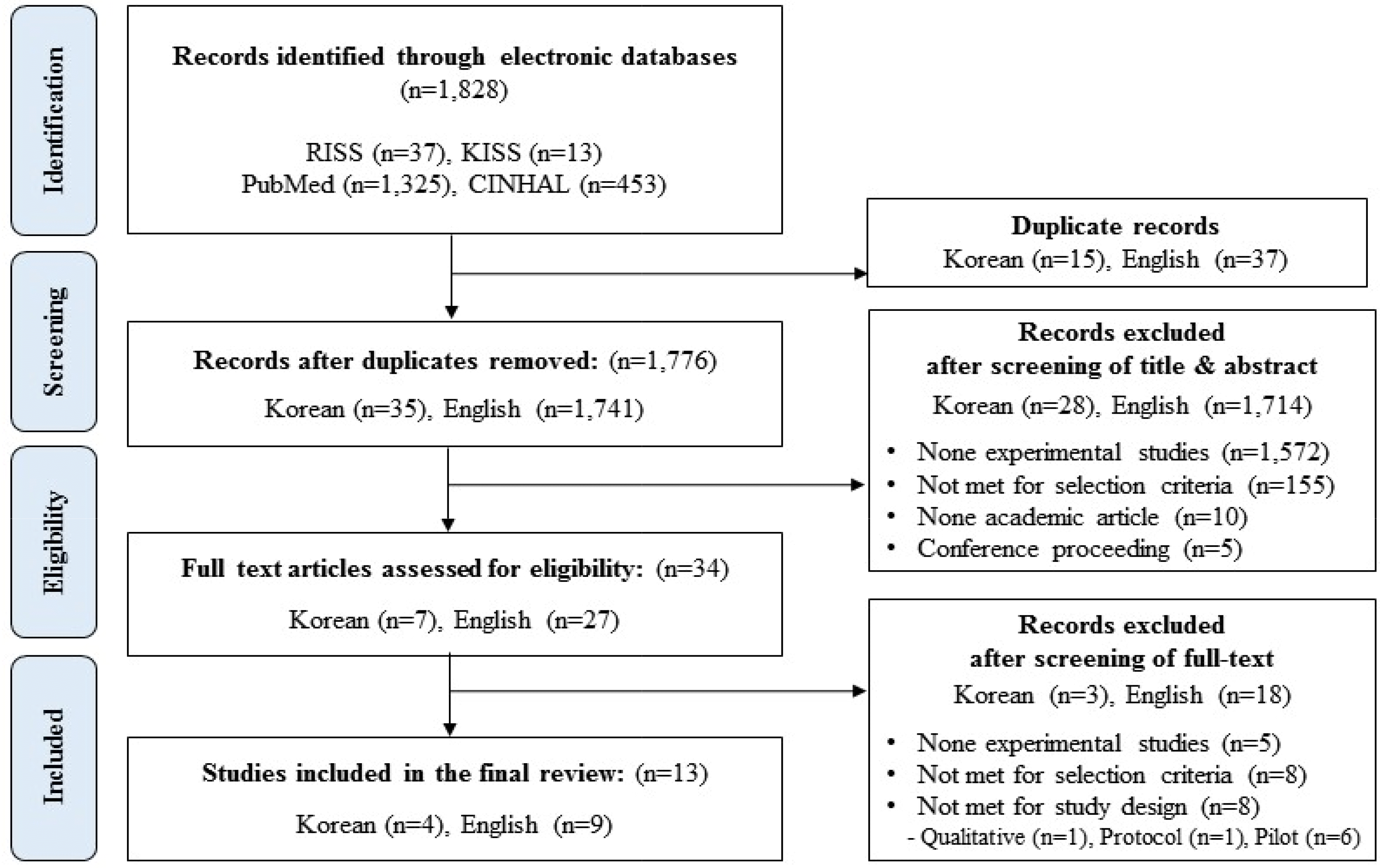Abstract
Purpose
Methods
Results
Conclusion
References
Table 1.
1.1=appropriate & clear question; 1.2=randomization; 1.3=allocation concealment; 1.4=blinding; 1.5=similarity; 1.6=differentiation; 1.7=valid & reliability; 1.8=rate of drop out (%); 1.9=intent to treat; 1.10=similarity between results; 2.1=appropriate & clear question; 2.2=comparable population; 2.3=same criteria; 2.4=participation rate (%); 2.5=comparison with accessible population; 2.6=clear case; 2.7=clear control; 2.8=primary exposure; 2.9=validity & reliability; 2.10=potential confounder; 2.11=confidence interval; Exp.=experimental; Cont.=control; Y=yes; N=no; −=low quality; +=acceptable; ++=high quality.
Table 2.
| 1st Author (year) | Country | Design | Setting | Sample | Participants | |||||
|---|---|---|---|---|---|---|---|---|---|---|
|
Exp. (n) |
Cont. (n) |
Total (N) |
Age (year or %) |
Career (year or %) |
Sex – Female (%) |
Complete† (%) |
||||
| Duarte (2016) | Portugal | Quasi exp. design | Oncology | 45 | 48 | 93 | 30∼51 | 8∼30 | 86.9 | 51.6 |
| El Khamali (2018) | i France | Randomized controlled trial | Intensive care unit | 101 | 97 | 198 | ≤30 (48.0%) | ≤5 (71.8%) | 58.0 | 91.9 |
| ≥41 (7.5%) | >5 (28.2%) | |||||||||
| Fang (2015) | China | Randomized controlled trial | Unclear | 61 | 59 | 120 | 25∼47 | 5∼23 | 100.0 | 87.5 |
| Henderson (2015) | USA | Quasi exp. design | Surgical | 50 | – | 50 | NR | ≤3 (48.0%) | 100.0 | 100.0 |
| ≥20 (12.0%) | ||||||||||
| Hersch (2016) | USA | Randomized controlled trial | Unclear | 52 | 52 | 104 | 22∼65 | <1 (8.0%) | 87.5 | 86.5 |
| >25 (30.0%) | ||||||||||
| Jang (2015) | Korea | Quasi exp. design | Oncology | 14 | 15 | 29 | ≤30 (37.9%) | <5 (48.2%) | 100.0 | 100.0 |
| >30 (62.1%) | ≥5 (51.8%) | |||||||||
| Ji (2017) | Korea | Quasi exp. design | Intensive care unit | 29 | 29 | 58 | 23∼33 | 1∼9 | NR | 89.6 |
| Kubota (2016) | Japan | Randomized controlled trial | Oncology | 50 | 46 | 96 | 33∼46 | NR | 96.4 | 85.4 |
| Lan (2014) | Malaysia | Quasi exp. design | Intensive care unit | 41 | – | 41 | 23∼35 | 1∼11 | 100.0 | 90.2 |
| Lee (2014) | Korea | Randomized controlled trial | Operating room | 27 | 27 | 54 | 22∼38 | <1∼14 | NR | 92.5 |
| Magtibay (2017) | USA | Quasi exp. design | Trans-plantation | 50 | – | 50 | 24∼63 | NR | NR | 66.0 |
| Riemer (2015) | USA | Quasi exp. design | Intensive care unit | 22 | – | 22 | NR | ≤5 (27.0%) | 82.0 | 100.0 |
| >10 (36.0%) | ||||||||||
| Seo (2015) | Korea | Quasi exp. design | Psychiatric | 6 | 6 | 12 | NR | NR | 66.6 | 100.0 |
Table 3.
| 1st Author (year) | Intervention | Effects on outcome | |||||||
|---|---|---|---|---|---|---|---|---|---|
| Program | Type | Delivery mode | Session/Times per session | Duration (wk)/Frequency | Control/Comparison | Job stress | Mental health | Others | |
| Duarte (2016) | MBI | CBT | Group Offline |
6 60 min |
6 1/week |
Wait-list | – |
Burnout† Stress† Anxiety† Depression† Rumination† Mindfulness† |
Compassion satisfaction† Compassion fatigue† Experiential avoidance† |
| El Khamali (2018) | Multimodal program | Simulation training | Group Offline |
5 unknown |
2 3/1st-wk 2/2nd-wk |
No intervention | Significant | – |
Isostrain† Absenteeism† Decision latitude† Social support† Psychological demand† |
| Fang (2015) | Yoga | CAT | Group Offline |
≥12 60 min |
6 ≥2/week |
No intervention | Significant | – | Quality of sleep† |
| Henderson (2015) | Hardiness program | CBT | Group Offline |
1 60 min |
one time | – | – |
Burnout† Hardiness† |
– |
| Hersch (2016) | BREATH program | Inform. training | Indvl. Online | no timeline |
12 no timeline |
Wait-list | Significant |
Distress symptom Coping with stress Anxiety Depression Use substances Drinking |
Work limitation Job satisfaction |
| Jang (2015) | Group art therapy | CBT | Group Offline |
8 90 min |
8 1/week |
No intervention | Significant | Burnout | – |
| Ji (2017) | Music therapy | CAT | Indvl. Offline |
1 30 min |
one time |
Rest w/o intervention |
– | Subjective stress response† |
Salivary cortisol† Fatigue† |
| Kubota (2016) | Psycho-oncology training | Inform. training | Group Offline |
2 480 min |
2 1/week |
Wait-list | Not significant | – | Confidence† Knowledge Attitudes |
| Lan (2014) | b-MBCT program | CBT | Group Offline |
5 120 min |
5 1/week |
– | – |
Perceived stress† Stress† Anxiety† Depression† Mindfulness† Subjective happiness† |
– |
| Lee (2014) | Foot bath therapy | CAT | Indvl. Offline | 12 20 min | 3 4/week | Rest w/o intervention | – |
Physical stress† Psychological stress |
Ankle edema Calf edema† Fatigue† |
| Magtibay (2017) | SMART program | CBT | Indvl. Online | no timeline | 24 no timeline | – | – |
Burnout† Perceived stress† Generalized anxiety† Resilience† Mindfulness† Subjective happiness† |
– |
| Riemer (2015) | Quiet time | Stimuli control | Group Offline | 1 120 min | one time | – | – | Stress† | – |
| Seo (2015) | Group art therapy | CBT | Group Offline | 12 90 min | 12 1/week | No intervention | Significant |
Emotional expression† Depression† |
– |




 PDF
PDF ePub
ePub Citation
Citation Print
Print



 XML Download
XML Download